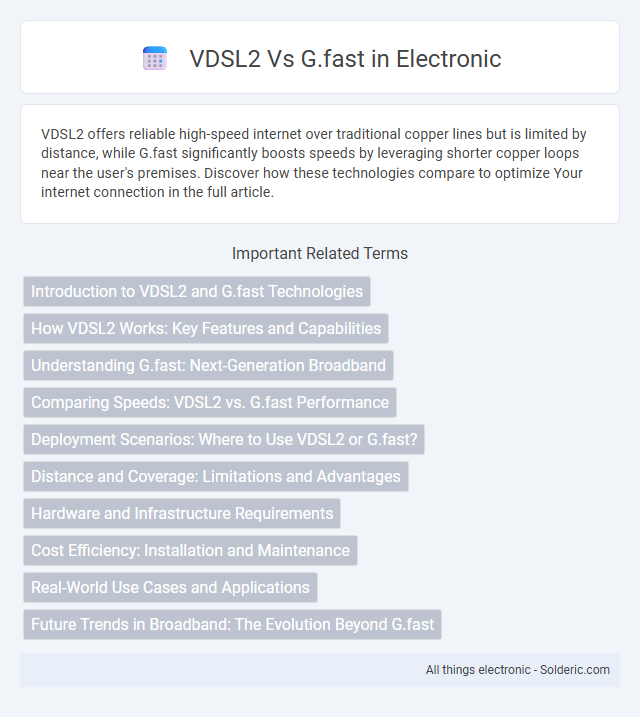VDSL2 offers reliable high-speed internet over traditional copper lines but is limited by distance, while G.fast significantly boosts speeds by leveraging shorter copper loops near the user's premises. Discover how these technologies compare to optimize Your internet connection in the full article.
Comparison Table
| Feature | VDSL2 | G.fast |
|---|---|---|
| Maximum Speed | Up to 100 Mbps | Up to 1 Gbps |
| Frequency Range | Up to 30 MHz | Up to 212 MHz |
| Typical Reach | Up to 1.5 km (0.9 miles) | Up to 250 meters (820 ft) |
| Deployment | Existing copper telephone lines | Copper lines with fiber backhaul, close to the user |
| Latency | Low | Very low |
| Use Case | High-speed broadband, IPTV, VoIP | Ultra-fast broadband, Fiber-to-the-distribution-point (FTTdp) |
Introduction to VDSL2 and G.fast Technologies
VDSL2 (Very-high-bit-rate Digital Subscriber Line 2) technology delivers broadband speeds of up to 100 Mbps over existing copper telephone lines, optimizing data transmission for distances typically under 1,000 meters. G.fast technology significantly increases speeds up to 1 Gbps by utilizing higher frequency bands while operating efficiently over short copper loops of less than 250 meters. Both technologies are integral to fiber-to-the-distribution-point (FTTdp) deployments, enabling ultra-fast internet access with minimal infrastructure changes.
How VDSL2 Works: Key Features and Capabilities
VDSL2 operates by utilizing higher frequency bands on existing copper telephone lines, enabling data transmission speeds up to 100 Mbps over short distances, typically within 1,200 meters. It supports multiple vectoring technology to reduce crosstalk interference, enhancing performance and stability in multi-line deployments. Your internet experience benefits from VDSL2's ability to deliver high-speed broadband services ideal for streaming, online gaming, and VoIP applications.
Understanding G.fast: Next-Generation Broadband
G.fast is a next-generation broadband technology designed to deliver ultra-fast internet speeds of up to 1 Gbps over existing copper telephone lines, significantly outperforming VDSL2, which typically maxes out around 100 Mbps. Unlike VDSL2, G.fast utilizes higher frequency bands up to 106 MHz or 212 MHz, reducing signal degradation and providing faster, lower-latency connections ideal for dense urban deployments. This innovation enables service providers to offer fiber-like speeds without costly fiber-to-the-home infrastructure upgrades.
Comparing Speeds: VDSL2 vs. G.fast Performance
G.fast technology delivers significantly higher speeds than VDSL2, reaching up to 1 Gbps over short copper loops, while VDSL2 maxes out around 100 Mbps at similar distances. The performance of G.fast sharply declines beyond 250 meters but outperforms VDSL2 in short-range applications, making it ideal for fiber-to-the-distribution-point deployments. Your choice depends on the existing infrastructure and required bandwidth, with G.fast offering future-proof, ultra-fast broadband in dense urban areas.
Deployment Scenarios: Where to Use VDSL2 or G.fast?
VDSL2 is ideal for deployments where fiber extends to street cabinets and existing copper lines connect the final meters, supporting speeds up to 100 Mbps over 300 meters. G.fast is suited for ultra-short copper loops under 250 meters, typically in fiber-to-the-basement or fiber-to-the-distribution-point scenarios, delivering speeds up to 1 Gbps. Operators choose VDSL2 for broad coverage with moderate speeds, while G.fast targets high-speed broadband upgrades in dense urban areas with shorter copper runs.
Distance and Coverage: Limitations and Advantages
VDSL2 provides stable high-speed internet over distances up to 1,200 meters, making it ideal for broader coverage in suburban areas. G.fast significantly outperforms VDSL2 within shorter distances, typically under 250 meters, delivering ultra-fast speeds ideal for dense urban settings or multi-dwelling units. Your choice between VDSL2 and G.fast should consider the specific coverage needs and physical line lengths to maximize performance efficiency.
Hardware and Infrastructure Requirements
VDSL2 requires traditional copper phone lines combined with existing DSLAMs and fiber backhaul infrastructure, enabling relatively simple upgrades for internet providers. G.fast, on the other hand, demands more advanced hardware like vectoring-enabled DSLAMs and fiber closer to the end-user, often necessitating substantial infrastructure improvements. Your choice between these technologies will depend on the existing network setup and investment capability for upgrading hardware to support higher speeds.
Cost Efficiency: Installation and Maintenance
VDSL2 typically offers lower installation and maintenance costs due to its widespread adoption and compatibility with existing copper infrastructure, making it a cost-efficient choice for many service providers. G.fast requires more specialized equipment and often shorter loop lengths, leading to higher initial deployment expenses but potentially lower operational costs through enhanced energy efficiency. You can optimize long-term investment by evaluating your network's existing infrastructure and bandwidth demands when choosing between these technologies.
Real-World Use Cases and Applications
VDSL2 technology excels in delivering high-speed internet to residential areas with existing copper infrastructure, supporting services like HD video streaming and online gaming within distances up to 1,000 meters from the distribution point. G.fast is optimized for ultra-fast broadband in dense urban environments, enabling gigabit speeds over short copper loops typically less than 250 meters, making it ideal for fiber-to-the-distribution-point (FTTdp) deployments and multi-dwelling units (MDUs). Enterprises seeking high-capacity connections in building backbones benefit from G.fast's ability to provide gigabit-class speeds without the cost of full fiber deployment.
Future Trends in Broadband: The Evolution Beyond G.fast
VDSL2 technology offers high-speed broadband over traditional copper lines but faces limitations in maximum speed and distance compared to emerging standards. G.fast significantly enhances bandwidth by utilizing higher frequencies, enabling gigabit speeds up to 500 meters, yet future trends emphasize the transition to full fiber deployments for ultra-fast, low-latency connections. Innovations beyond G.fast focus on fiber-to-the-distribution-point (FTTdp) architectures and next-generation technologies like XG-Fast and 25G PON, driving broadband evolution toward higher capacity and scalability.
VDSL2 vs G.fast Infographic

 solderic.com
solderic.com